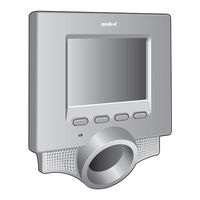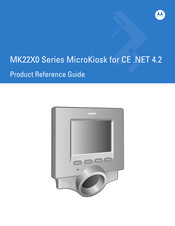Motorola MK2290 Data Terminal Manuals
Manuals and User Guides for Motorola MK2290 Data Terminal. We have 2 Motorola MK2290 Data Terminal manuals available for free PDF download: Reference Manual, Product Reference Manual
Motorola MK2290 Product Reference Manual (334 pages)
MK22X0 Series MicroKiosk for CE .NET 4.2
Brand: Motorola
|
Category: Barcode Reader
|
Size: 9.89 MB
Table of Contents
-
-
Overview21
-
MK22X0 Parts21
-
-
-
Peripherals44
-
COM Port44
-
-
-
Overview53
-
System Menu57
-
-
Figure
82 -
-
Overview83
-
-
Enabling DHCP106
-
-
-
-
Overview115
-
-
Main Menu Bar120
-
Attract Mode120
-
Printing123
-
Loyalty Program124
-
Kichenaid Mixer127
-
Gift Registry128
-
-
-
Calculator131
-
-
Screen Layout137
-
Printing137
-
Scan Engine138
-
Magstripe Reader138
-
Advertising139
-
Device Startup139
-
-
-
-
Overview141
-
-
Main Menu Bar144
-
Attract Mode146
-
Loyalty Program147
-
-
-
-
Network Security156
-
-
Regmerge.dll160
-
Copyfiles160
-
-
FTP Server165
-
-
Simplesaver166
-
Slideshow166
-
-
-
Browsing the Web174
-
-
MSR Object Test176
-
-
Overview187
-
Aegis Client188
-
Find Wlans202
-
Status203
-
Options206
-
-
-
Overview207
-
-
Profile ID212
-
Operating Mode213
-
Ad-Hoc215
-
Security Mode216
-
Authentication217
-
Encryption227
-
IP Address Entry231
-
Transmit Power233
-
Battery Usage235
-
-
Manage Pacs241
-
PAC Properties241
-
Delete PAC241
-
-
-
Versions Window247
-
-
ICMP Ping Window249
-
Graphs249
-
Known Aps Window251
-
-
Options252
-
Band Selection253
-
System Options254
-
Change Password255
-
Export256
-
-
-
Overview261
-
-
-
Overview267
-
Wide Screen TV267
-
DVD Player268
-
Glue Stick269
-
Transparent Tape269
-
Standard Staples270
-
Tylenol270
-
Rolaids271
-
Kichenaid Mixer272
-
Employee Badge273
-
Loyalty Card273
-
Bar Code (PDF417274
-
-
-
Overview275
-
Pants UPC-A275
-
Transparent Tape276
-
Employee Badge277
-
Loyalty Card277
-
-
-
Overview279
-
-
-
-
Overview301
-
Troubleshooting303
-
-
-
Overview309
-
Default Table309
-
-
Index
323
Advertisement
Motorola MK2290 Reference Manual (334 pages)
CE .NET 4.2
Brand: Motorola
|
Category: Touch terminals
|
Size: 10.04 MB
Table of Contents
-
Introduction17
-
-
Overview21
-
MK22X0 Parts21
-
Software25
-
Touch Screen25
-
Memory25
-
Smart Raster29
-
-
-
Peripherals44
-
COM Port44
-
-
Overview53
-
System Menu57
-
Applications58
-
Update74
-
Figure82
-
-
-
Overview83
-
Row Colors90
-
State Icons90
-
Enabling DHCP106
-
-
-
Overview115
-
Main Menu Bar120
-
Attract Mode120
-
Printing123
-
Loyalty Program124
-
Kichenaid Mixer127
-
Gift Registry128
-
Calculator131
-
Screen Layout137
-
Printing137
-
Scan Engine138
-
Magstripe Reader138
-
Advertising139
-
Device Startup139
-
-
-
Overview141
-
Main Menu Bar144
-
Attract Mode146
-
Loyalty Program147
-
Screen Layout152
-
Button Control152
-
Version Tracking152
-
Video Playback153
-
-
-
Network Security156
-
Regmerge.dll160
-
Copyfiles160
-
FTP Server165
-
Simplesaver166
-
Slideshow166
-
Browsing the Web174
-
MSR Object Test176
-
-
Overview187
-
Aegis Client188
-
Editing Profiles192
-
Find Wlans202
-
Status203
-
Options206
-
-
-
Overview207
-
Profile ID212
-
Operating Mode213
-
Ad-Hoc215
-
Security Mode216
-
Authentication217
-
Encryption227
-
IP Address Entry231
-
Transmit Power233
-
Battery Usage235
-
Manage Pacs241
-
PAC Properties241
-
Delete PAC241
-
Versions Window247
-
ICMP Ping Window249
-
Graphs249
-
Known Aps Window251
-
Options252
-
Band Selection253
-
System Options254
-
Change Password255
-
Export256
-
-
-
Overview261
-
-
-
Overview267
-
Wide Screen TV267
-
DVD Player268
-
Glue Stick269
-
Transparent Tape269
-
Standard Staples270
-
Tylenol270
-
Rolaids271
-
Kichenaid Mixer272
-
Employee Badge273
-
Loyalty Card273
-
Bar Code (PDF417274
-
-
-
Overview275
-
Pants UPC-A275
-
Transparent Tape276
-
Employee Badge277
-
Loyalty Card277
-
-
-
Overview279
-
-
-
Overview301
-
Troubleshooting303
-
-
-
Overview309
-
C Api309
-
Default Table309
-
Index323
-

